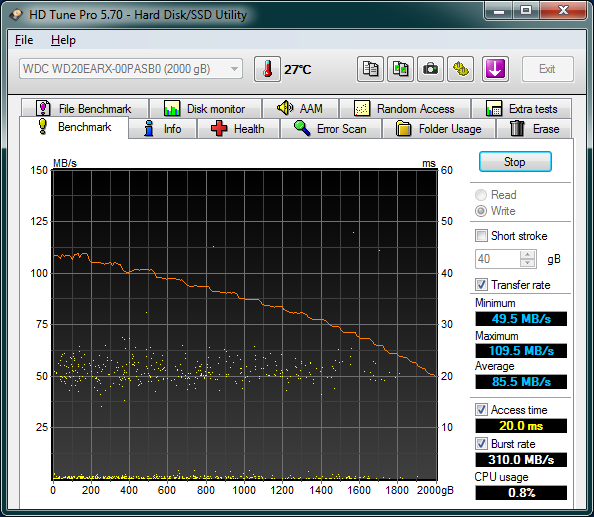This is yet another drive from the era of “green”, a Western Digital Caviar Green (before they dropped the Caviar name entirely). A mostly trouble-free drive series, I’ve had very good experience with all of the WDxxEARX drives in my fleet.
The Drive
This 2TB drive was manufactured 18th June 2012 and sports the WD Caviar Green branding in its lime-green colouration, as per the GreenPower that came before it. Later, this would transition to just “Green” with a darker, leafier green. Nevertheless, this is one of the “advanced format” drives with 4kB native sectors which did require some care in setup to maximise performance through partition alignment. Many drives larger than 500GB were advanced format to reduce overheads in internal formatting.
The drive’s casted base doesn’t quite maximise the internal volume, so they haven’t quite crammed the maximum number of platters in just yet. This is something they would do in coming years in their desperation to keep up the capacity race. Otherwise, with its reduced PCB size, it is otherwise typical for a WD drive.
The base has the same boxy appearance and cut-outs that we have come to expect from WD.
Nothing different about the labelling either – serial number barcode on the opposite side to the SATA connector. The lid is ever-so-slightly deformed by the screw – not the worst example however.
Performance Testing
CrystalDiskInfo
The drive is still somewhat young at 15248 hours of operation and shipped with firmware 51.0AB51. This drive supports SATA3 connectivity, although it really doesn’t need it much. The drive is pretty healthy although the single count under Read Error Rate may suggest some ageing is taking place.
HD Tune
Sequential reads ranged from 110.1MB/s down to 49.5MB/s, averaging at 85.9MB/s with an access time of 15.6ms.
While the read curve was nice and smooth, the write curve shows some disturbances towards the outer zones, likely an effect of ageing. The rates ranged from 109.5MB/s down to 49.5MB/s, averaging 85.5MB/s with an average access time of 20ms. This long access time seems to be affected by significant outliers which may reflect drive internal retries.
Peak IOPS reached 63 for reads and 83 for writes, the latter is perhaps a bit lacklustre.
Cache effects are visible on the read, although it seems only to reach SATAII rates instead. The implied cache size is 16MB. The effect on writes seems more limited.
Full performance appears to be reached by 16kB accesses.
CrystalDiskMark
Sequential reads reached 118.4MB/s, with sequential writes reaching 115.3MB//s. Medium block 512kB accesses reached 46.83MB/s in read and 66.18MB/s in write. Small block accesses were helped by NCQ at QD32, reaching 1.586MB/s for reads and 0.875MB/s for writes. Not sure why the writes on this particular drive seem to lag behind others in its class – could just be that this drive is no longer as healthy as it once was.
ATTO
ATTO seems to show that full performance is attainable at around 8kB accesses, which is quite positive.

















